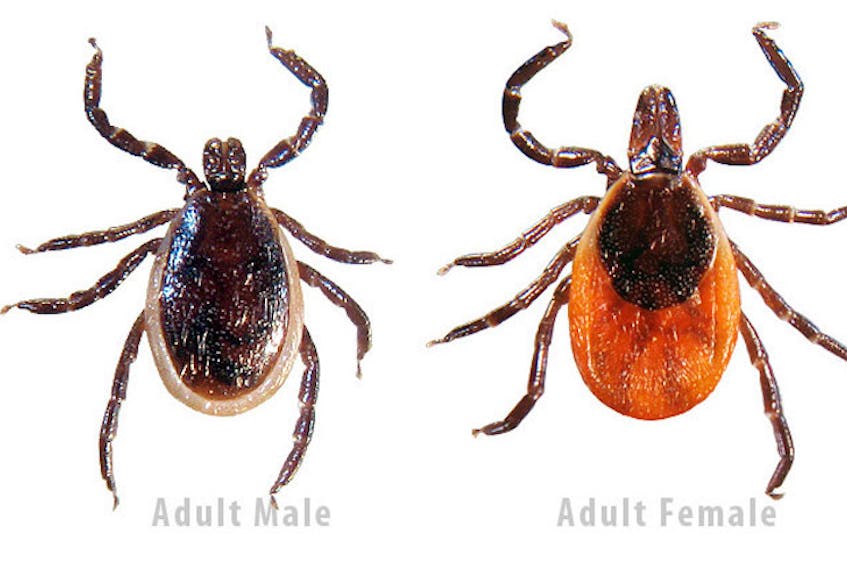News that a Bridgewater massage therapist picked ticks off three of her clients in one week came as no surprise to an expert on the bloodsucking parasites.
Vett Lloyd, a Mount Allison University biologist, says no other place in Canada rivals the ballooning tick population on the province’s South Shore, with Ontario being the possible exception.
“The South Shore area is probably the worst place in Canada,” said Lloyd, a member of the university’s tick and Lyme disease research centre.
“Ontario might give you a run for the money, but you may win.
The ticks aren’t going anywhere so we have to adjust to them. It will probably get worse, but the South Shore is probably as close to as bad as it can get, and that includes the whole South Shore, Yarmouth up to Chester.”
Massage therapist Kelly Cook said she removed four ticks from three of her clients during the first week of May. She shared the news in a May 13 Facebook post that garnered plenty of replies, including from one woman saying she had contracted Lyme disease last year and never saw a tick or a bite mark.
This reporter, who resides in Chester Basin, spotted a tick on his belly last Sunday. Luckily, it was not feeding.
The personal accounts coincide with a Lyme disease education and prevention campaign launched by the Municipality of the District
of Lunenburg this month. Lloyd says the initiative is essential, and residents must be on a constant lookout for blacklegged ticks especially.
“Because you have such a high tick population there’s really not a lot of places you won’t find them,” said Lloyd.
“It’s got to become like brushing your teeth. You do it before bed, and really you should be doing it every time you come indoors. Once they start biting and feeding they can start transmitting disease. There’s no vaccine for humans. The only way to protect yourself is catching the ticks before they bite.”
According to the province’s Heath and Wellness Department, the risk of Lyme disease is increasing. This year, 13 areas of the province are considered high-risk, up from six last year. In 2016, the number of reported cases of the disease in the province rose to 326, up from 247 in 2015. This year’s figures have yet to be released.
But how did the South Shore become a tick haven?
“The South Shore has the perfect climate for ticks,” said Lloyd.
“The climate is mild, it’s moist, lots of fog, you have plenty of boggy areas that keep everything moist. They were introduced primarily on migratory birds.
Once they came, they decided they liked it, and once an adult female gets a full blood meal she can lay 2,000 to 5,000 eggs.”
Scarier still is that there is a new European strain of Lyme disease emerging that standard testing doesn’t pick up, Lloyd said. It’s a particular pathogen strain found in European ticks, which have made their way over to Canada via birds or humans.
They’ve been found in Nova Scotia and New Brunswick, leading Lloyd to believe some Nova Scotians are unknowingly infected.
“It’s almost certain. I can’t see how that would not be the case.
The big challenge is figuring what’s inside of ticks and then transmitting that information to the people who can help patients.” The number of reported cases of Lyme disease in all provinces increased from 144 in 2009 to 992 in 2016, according to federal public health data.
In 2016, more than 88 per cent of the cases reported were from Nova Scotia, Quebec and Ontario. Nova Scotia reported the highest incidence in Canada in 2016 at 34.4 per 100,000 population, 12.7 times the national average.
Of course, there are other species of ticks not of the blacklegged variety, including American dog ticks, which carry other dangerous bacteria and pathogens that can lead to nasty conditions.
All of them can carry disease, and the tick population is expanding northward, Lloyd said.
Most people never feel a tick bite because the parasites deliver an anesthetic before they bury their heads beneath skin.
“If you talk to anyone with any of the tick-born illnesses, they are really nasty,” said Lloyd.
“It’s well worth people’s time to check themselves regularly. If something is feeding on your blood, really, you need to get them off you.”









